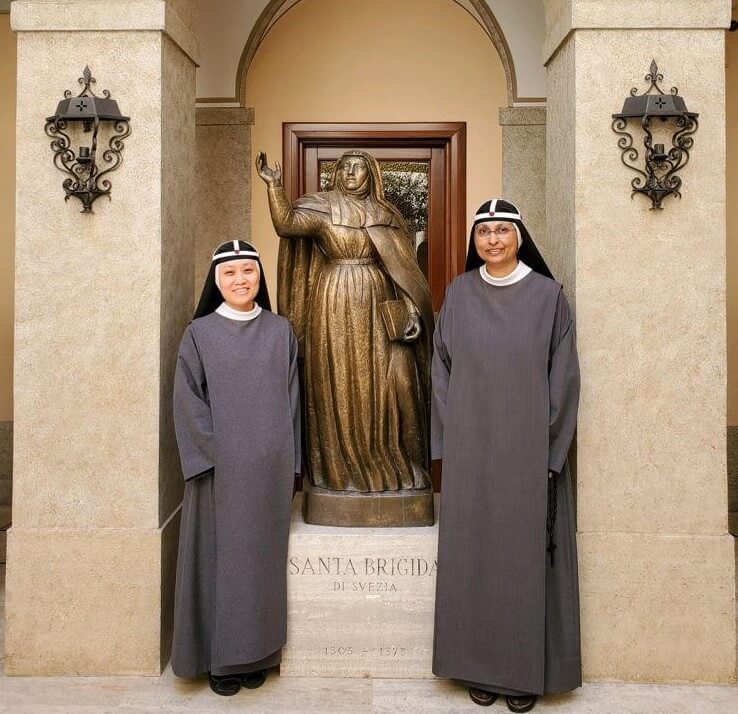Bridget of Sweden | In the Footsteps of Saints
While in Rome, the 2021 Rome Experience stayed at the beautiful Casa di Santa Brigida, run by the Bridgettine sisters. We are so grateful for the community’s warm welcome and over-and-above hospitality!
On the occasion of St. Bridget’s feast — today, July 23 — two seminarians share her story as told to them while in residence at the saint’s historic home…
The Bridgettine Sisters Work for Unity of the Church
By Benjamin Mersch, Archdiocese of Cincinnati and Thong Nguyen, Archdiocese of Washington, D.C.
A young noblewoman who lived in the 14th century is still influencing the lives of people today through the order she founded. Visitors to Rome who stay at the Casa di Santa Brigida on the northwest corner of the Piazza Farnese, beside the church dedicated to her, have the opportunity not only to experience the hospitality of the Bridgettine sisters, but can – by request – visit the rooms of St. Bridget where she lived and died and where some of her relics are visible. Below the main church, there is also a Lutheran chapel dedicated to her daughter St. Catherine of Sweden. The location also has a connection to a third saint, St. Maria Elizabeth Hesselblad, who re-founded the Order here in Rome: the “Order of the Most Holy Savior of St. Bridget”.
The main charism of the Bridgettine sisters, while cloistered at the time of St. Bridget, is one of penance and prayer for the unity of the Church while living in community. One of the first things someone would notice about the Bridgettine sisters is the distinctive headwear, like a crown connected to a white band – which represents purity – in the shape of a cross, with red markers at the intersections over a black cloth. These red marks indicate the five wounds of our Lord Jesus. The crest of the order includes this indication of the five wounds of Christ. The black veil represents their death to the things of this world, and the gray habit represents penance.
St. Bridget was devoted to the Passion of Christ and the Humanity of the Word Incarnate, Mother General Fabia Kattakayam said. St. Bridget was born in Sweden in 1303 to an aristocratic family that was religious but had political connections, and she was married at the young age of thirteen due to the will of her father. Even at a young age she showed signs of a close connection to God. At the age of seven, she received a vision of the Blessed Mother giving her a crown. At the age of ten, after listening to a Lenten homily, she had a vision of the crucified Lord. When she asked who did this to Him, He replied, “All those who refuse my love.” After the death of her husband, she stayed for two years at the Cistercian monastery in Alvastra in order to discern; she heard God’s call to be a spouse of Christ, and she felt a call from the Lord to found a new religious order. She left for Rome in 1349 to get approval for the new order, which she received in 1370. Her intention in coming to Rome was also to attempt to convince Pope Urban V to return to Rome from Avignon and to obtain an indulgence in the Holy Year of 1350. Of her eight children, one of her daughters, who later became St. Catherine of Sweden, followed her into the religious order and was the first abbess. According to a book about the life of St. Maria Elizabeth Hesselblad, before passing away St. Bridget entrusted Catherine with a message, “patience and silence.”
The third saint connected to the house, St. Maria Elizabeth Hesselblad, started her journey after reading Jesus’ prayer for the Church to be one in John 17. She was born into a Protestant family in Sweden. At sixteen years of age, she emigrated to the United States and attempted to understand her vocation and to find the church to where she was being called. She took part in various charitable groups and denominations and eventually understood she was called to the Catholic Church. The final confirmation of this call she acquired during a Procession of Corpus Domini in Brussels in 1900 when she heard the voice of Jesus state, “It is me for whom you search.”
In her early childhood she had a dream of the house of St. Bridget and after many years in 1903, she was in Rome with her two Catholic friends when passing by the Church of Saint Bridget. Entering the church, she heard God’s voice telling her, “It is here I want you to serve me.” After previously having spent time in formation with the Carmelite sisters who were at that time residing at Casa di Santa Brigida in Rome, she decided to make her First Profession as a Bridgettine sister. She started visiting the existing Bridgettine communities in 1909 to learn the spirituality and the traditions, and in 1911, with three English girls, she started the Bridgettine Order in Rome at Casa di Santa Brigida. After twenty years, the daughters of St. Bridget finally reclaimed the house of their grand Mother. Beside ancient spirituality, St. Elizabeth focused on spiritual ecumenism. Mother Abbess Fabia Kattakayam stated, “St. Elizabeth understood that only prayer can bring us unity. She tried to soothe the prejudice among the Catholic and Lutheran Churches for a better ecumenical journey, and later on understood that has to focus on unity but not uniformity.”
The process of discernment for women interested in joining the Bridgettines involves starting in aspirancy and postulancy which can last from one year up to three years together, then the candidate enters the period of novitiate for a year and a half before making their first profession. Six years later, they make their Final Profession, when they receive a ring of the order. The sisters make vows of chastity, poverty, and obedience.
The sisters at the Casa di Santa Brigida number at thirty, although there are six hundred Bridgettine sisters throughout the world in fifty-seven convents. At the Casa di Santa Brigida, the daily schedule includes the Liturgy of the Hours prayers of the Church, Mass, adoration, and time for meditation and studies, in addition to operating the Casa, which is their source of financial support but also serves the purpose of witnessing to life. In all Bridgettine communities, the sisters focus on celebrating the Liturgy solemnly and in common.
“There is nothing better than to understand the value and meaning of life,” Mother Kattakayam said. “Material life will not give us what we seek. Worldly pleasures may give some satisfaction, but not the pleasure that lasts forever.” She does not view her life as one of renunciations, “because if we are filled with the grace of the Lord, we do not need ephemeral pleasures.” Mother Fabia Kattakayam said some young people today are influenced by celebrities, but we need spiritual influences in our lives to follow Christ. Remembering the stories and examples of the saints gives us those spiritual celebrities that we can follow in our lives as we all pursue a calling ourselves to become saints. For the Bridgettines, Sts. Bridget, Catherine, and Maria Elizabeth Hesselblad were those influences.
The feast of St. Bridget is celebrated on July 23, the feast of St. Catherine on March 24, and the feast of St. Maria Elizabeth Hesselblad on June 4.
Following the founders of the Order, the Bridgettine sisters yesterday, today, and forever continue to pray for the unity of the Church as Jesus prayed to His Heavenly Father, “that they may be one even as we are one.”
For more information about the Bridgettine order visit www.brigidine.org.
Pictured (left to right) are Sister Irenea Dang, who has been with the Bridgettines for 20 years and Mother Abbess General Fabia Kattakayam, who has been with the Bridgettines for 39 years with a statue of St Bridget. Photo by Benjamin Mersch.


